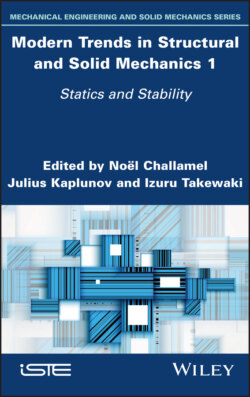Читать книгу Modern Trends in Structural and Solid Mechanics 1 - Группа авторов - Страница 15
1.1. Introduction
ОглавлениеComposites are being increasingly used in transportation, aviation and defense industries because of their high specific strength and our ability to tailor their elastic moduli and ultimate strengths in desired directions and at critical locations in the structure. They are usually in the form of a laminate composed of numerous plies, with each ply having unidirectional fibers. The volume fraction of fibers in different plies can be varied to suit the intended application. Recognizing that design is an iterative process, it is imperative that we can easily and accurately analyze a structure’s response to external stimuli.
Closed-form solutions for three-dimensional linear elasticity equations for composite laminates are scarce. Assuming that the Euler–Bernoulli beam theory applies to a composite laminated beam and the Kirchhoff–Love theory is relevant for a composite laminated plate, enables us to analytically solve some boundary value problems (see, for example, Jones (1998) and Hyer (2009)). Elishakoff has reviewed various theories for plates and laminates and has provided their historical perspective (Elishakoff 2018). However, for general structures, we resort to numerical methods for solving the governing equations.
A challenge in solving problems for laminates is accurately finding transverse stresses that can cause delamination between adjacent plies. For simply supported edges, the linear elasticity equations have been solved by expressing the three displacements as double Fourier series in the in-plane coordinates and deducing ordinary differential equations for them in the thickness direction (Vlasov 1957; Pagano 1969; Srinivas and Rao 1970). For other boundary conditions at the edges, Vel and Batra employed the Eshelby–Stroh formalism and satisfied boundary conditions at the edges in the sense of Fourier series (Vel and Batra 1999; Vel and Batra 2000) that rely on St. Venant’s principle. This principle states that the solution at points away from the edges is unaffected by the boundary conditions, provided that they are equipollent to the same resultant force and moment (Toupin 1965). The distance from the edges, usually called the decay length, where the solution is unaffected, depends on the lowest frequency of free vibrations of a slice of the structure of characteristic length l and the maximum eigenvalue of the elasticity matrix. For composite laminates, the decay length has been estimated in Horgan and Baxter (1998).
A common approach, called the state space method, is to take the three transverse stresses and the three displacements as variables, cast governing equations for them as first-order partial differential equations (PDEs) in the thickness coordinate, z, and find their values simultaneously. The boundary value problem is thus reduced to one that looks like an initial value problem. One way to solve these PDEs is to find a propagation matrix that relates variables for two different values of z (see, for example, Bahar (1975)). Kant and Ramesh have presented Goldberg and Bogdanoff’s method of numerically solving these six first-order equations (Goldberg and Bogdanoff 1957; Kant and Ramesh 1981) that satisfy the prescribed boundary conditions at the top and the bottom surfaces of a plate. Here, we also solve for the three in-plane strains, along with the aforementioned six unknowns, use the least-squares method, polynomial basis functions of possibly different orders in each one of the three directions defined on the entire structure’s domain, include in the functional to be minimized boundary conditions at the six edges of a laminate and derive a set of simultaneous algebraic equations; see, for example, Moleiro et al. (2011) who have analyzed numerous problems. The contribution of this work is in demonstrating that polynomial basis functions defined on the entire domain enable us to find a reasonably accurate solution of the linear elasticity equations, for rectangular composite laminates of side length equal to twice the thickness and sandwich structures with the ratio of the axial elastic modulus of a facesheet to that of the core less than 1000.
The rest of the chapter is organized as follows. The problem formulation is described in section 1.2. In section 1.3, the developed algorithm is verified by comparing predictions from it with the analytical solutions for a simply supported four-layer laminate and a sandwich structure, which also has results for a three-layer laminate with two opposite edges simply supported and the other two edges either free or clamped. Significant outcomes of the work are briefly summarized as conclusions.
